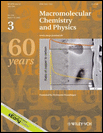Characterization of Solvation Environment Provided by Dilute Poly(sulfonyl maleic anhydride-co-dodecyl vinyl ether) Solutions at Various pH Using Pyrene and 1,3-Bis(1-pyrenyl)propane as Fluorescence Probes
Abstract
Solubilization environments afforded by dilute aqueous solutions of poly(sulfonyl maleic anhydride-co-dodecyl vinyl ether) [PSMADVE, 1 wt.-%] at pH 4, 7, and 10 are investigated using pyrene and 1,3-bis(1-pyrenyl)propane as fluorescence probes. While pyrene is a common polarity probe, intramolecular excimer formation in 1,3-bis(1-pyrenyl)propane makes it an interesting cybotactic region microviscosity probe. Results for pyrene II/IIII indicate that the most hydrophobic solubilization site is afforded at pH 4 followed by pH 10 and pH 7. The dipolarity indicated by pyrene is similar to that observed in m- and o-xylene, toluene, and butyl benzoate. The solvation microenvironment afforded by the PSMADVE solutions is more hydrophobic than that observed within sodium dodecyl sulfate micellar solution. Additionally, further investigation of the relative size of the solubilization site revealed that the polymer solutions promoted intermolecular pyrene excimer formation at relatively low pyrene concentrations, indicating the possibility of localized concentration enhancement within the solvation pockets and/or compartmentalization of the solute molecules. This observation was most prominent at pH 10 and least at pH 7. 1,3-Bis(1-pyrenyl)propane intramolecular excimer formation efficiency at pH 4 is slightly higher than that for neat ethylene glycol, while at pH 10 is similar to that observed in 1-octanol or dimethyl sulfoxide. Anomalously high excimer-to-monomer intensity ratio at pH 7 could be due to probe ground state heterogeneity, i.e., the existence of probe moieties in the ground state where the two pyrenyl groups are already aggregated. This is demonstrated by the fluorescence excitation data. Presence of the ground state aggregated form may give rise to anomalously high excimer formation efficiency.




